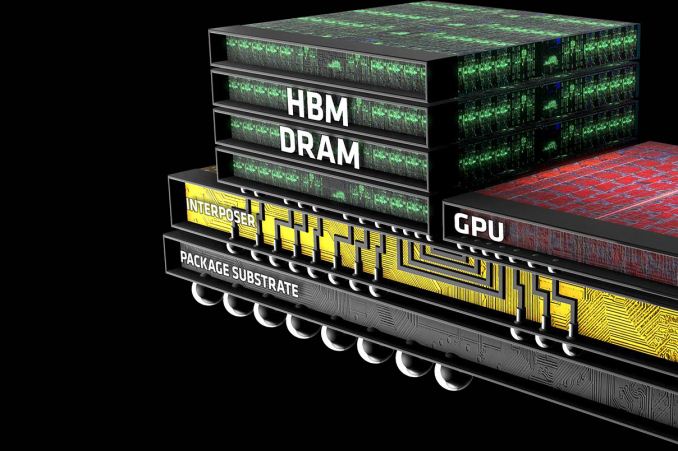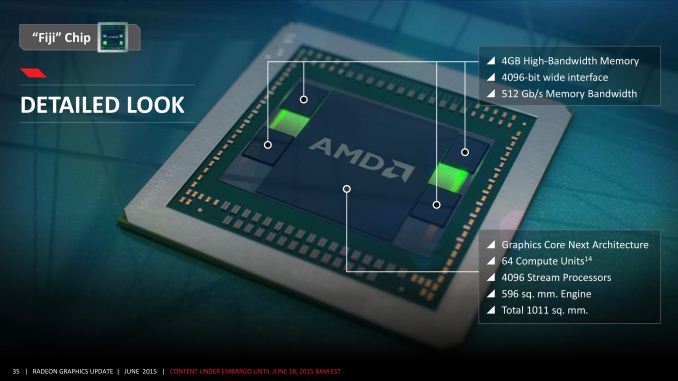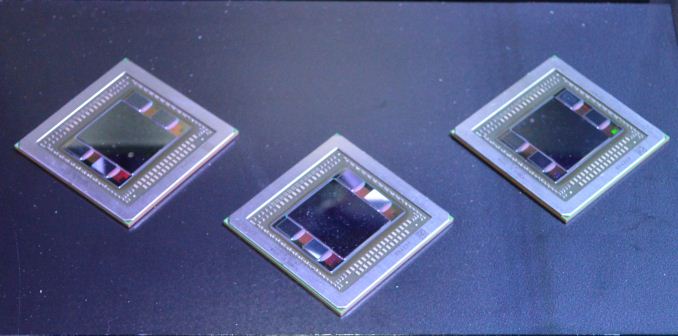The AMD Radeon R9 Fury X Review: Aiming For the Top
by Ryan Smith on July 2, 2015 11:15 AM ESTThe Fiji GPU: Go Big or Go Home
Now that we’ve had a chance to take a look at the architecture backing Fiji, let’s talk about the Fiji GPU itself.
Fiji’s inclusion of High Bandwidth Memory (HBM) technology complicates the picture somewhat when talking about GPUs. Whereas past GPUs were defined by the GPU die itself and then the organic substrate package it sits on, the inclusion of HBM requires a third layer, the silicon interposer. The job of the interposer is to sit between the package and the GPU, serving as the layer that connects the on-package HBM memory stacks with the GPU. Essentially a very large chip without any expensive logic on it, the silicon interposer allows for finer, denser signal routing than organic packaging is capable of, making the ultra-wide 4096-bit HBM bus viable for the first time.
We’ll get to HBM in detail in a bit, but it’s important to call out the impact of HBM and the interposer early, since they have a distinct impact on how Fiji was designed and what its capabilities are.
As for Fiji itself, Fiji is unlike any GPU built before by AMD, and not only due to the use of HBM. More than anything else, it’s simply huge, 596mm2 to be precise. As we mentioned in our introduction, AMD has traditionally shied away from big chips, even after the “small die” era ended, and for good reason. Big chips are expensive to develop, expensive to produce, take longer to develop, and yield worse than small chips (this being especially the case early-on for 40nm). Altogether they’re riskier than smaller chips, and while there are times where they are necessary, AMD has never reached this point until now.
The end result is that for the first time since the unified shader era began, AMD has gone toe-to-toe with NVIDIA on die size. Fiji’s 596mm2 die size is just 5mm2 (<1%) smaller than NVIDIA’s GM200, and more notably still hits TSMC’s 28nm reticle limit. TSMC can’t build chips any bigger than this; Fiji is as big a chip as AMD can order.
| AMD Big GPUs | ||||
| Die Size | Native FP64 Rate | |||
| Fiji (GCN 1.2) | 596mm2 | 1/16 | ||
| Hawaii (GCN 1.1) | 438mm2 | 1/2 | ||
| Tahiti (GCN 1.0) | 352mm2 | 1/4 | ||
| Cayman (VLIW4) | 389mm2 | 1/4 | ||
| Cypress (VLIW5) | 334mm2 | 1/5 | ||
| RV790 (VLIW5) | 282mm2 | N/A | ||
Looking at Fiji relative to AMD’s other big GPUs, it becomes very clear very quickly just how significant this change is for AMD. When Hawaii was released in 2013 at 438mm2, it was already AMD’s biggest GPU ever for its time. And yet Fiji dwarfs it, coming in at 158mm2 (36%) larger. The fact that Fiji comes at the latter-half of the 28nm process’s life time means that such a large GPU is not nearly as risky now as it would have been in 2011/2012 (NVIDIA surely took some licks internally on GK110), but still, nothing else we can show you today can really sell the significance of Fiji to AMD as much as the die size can.
And the fun doesn’t stop there. Along with producing the biggest die they could, AMD has also more or less gone the direction of NVIDIA and Maxwell in the case of Fiji, building what is unambiguously the most gaming/FP32-centric GPU the company could build. With GCN supporting power-of-two FP64 rates between 1/2 and 1/16, AMD has gone for the bare minimum in FP64 performance that their architecture allows, leading to a 1/16 FP64 rate on Fiji. This is a significant departure from Hawaii, which implemented native support for ½ rate, and on consumer parts offered a handicapped 1/8 rate. Fiji will not be a FP64 powerhouse – its 4GB of VRAM is already perhaps too large of a handicap for the HPC market – so instead we get AMD’s best FP32 GPU going against NVIDIA’s best FP32 GPU.
AMD’s final ace up their sleeve on die size is HBM. Along with HBM’s bandwidth and power benefits, HBM is also much simpler to implement, requiring less GPU space for PHYs than GDDR5 does. This is in part due to the fact that HBM stacks have their own logic layer, distributing some of the logic on to each stack, and furthermore a benefit of the fact that the signaling logic that remains doesn’t have to be nearly as complex since the frequencies are so much lower. 4096-bits of HBM PHYs still takes up a fair bit of space – though AMD won’t tell us how much – but it’s notably lower than the amount of space AMD was losing to Hawaii’s GDDR5 memory controllers.
The end result is that not only has AMD built their biggest GPU ever, but they have done virtually everything they can to maximize the amount of die space they get to allocate to FP32 and rendering resources. Simply put, AMD has never reached so high and aimed for parity with NVIDIA in this manner.
Ultimately this puts Fiji’s transistor count at 8.9 billion transistors, even more than the 8 billion transistors found in NVIDIA’s GM200, and, as expected, significantly more than Hawaii’s 6.2 billion. Interestingly enough, on a relative basis this is almost exactly the same increase we saw with Hawaii; Fiji packs in 43.5% more transistors than Hawaii, and Hawaii packed in 43.9% more transistors than Tahiti. So going by transistors alone, Fiji is very much to Hawaii what Hawaii was to Tahiti.
Finally, as large as the Fiji GPU is, the silicon interposer it sits on is even larger. The interposer measures 1011mm2, nearly twice the size of Fiji. Since Fiji and its HBM stacks need to fit on top of it, the interposer must be very large to do its job, and in the process it pushes its own limits. The actual interposer die is believed to exceed the reticle limit of the 65nm process AMD is using to have it built, and as a result the interposer is carefully constructed so that only the areas that need connectivity receive metal layers. This allows AMD to put down such a large interposer without actually needing a fab capable of reaching such a large reticle limit.
What’s interesting from a design perspective is that the interposer and everything on it is essentially the heart and soul of the GPU. There is plenty of power regulation circuitry on the organic package and even more on the board itself, but within the 1011mm2 floorplan of the interposer, all of Fiji’s logic and memory is located. By mobile standards it’s very nearly an SoC in and of itself; it needs little more than external power and I/O to operate.













458 Comments
View All Comments
K_Space - Thursday, July 2, 2015 - link
Between now and 2016 (preferably before the holiday season) I see AMD dropping the Fury X price and churning up better drivers; so it's not all too bleak. But it's still annoying that both of these could have been fixed before launch.dragonsqrrl - Thursday, July 2, 2015 - link
Yep, the Fury X is essentially vaporware at this point. It basically doesn't exist. Some tech journalists with inside information have estimated that fewer than 1000 were available for NA at launch. Definitely some supply issues to say the least, which I suspect is mostly due to the HBM.I have no idea why AMD hyped up Fiji so much prior to launch. In a sense they just made it that much more difficult for themselves. What kind of reaction were they expecting with rhetoric like "HBM has allowed us to create the fastest GPU in the world", along with some of the most cherry picked pre-launch internal benchmarks ever conceived? It just seems like they've given up and are only trying to engage their most zealous fanboys at this point.
All that being said, I don't think Fury X is a terrible card. In fact I think it's the only card in AMDs current lineup even worth considering. But unfortunately for AMD, the 980Ti is the superior card right now in practically every way.
chizow - Thursday, July 2, 2015 - link
Yep, it is almost as if they set themselves up to fail, but now it makes more sense in terms of their timing and delivery. They basically used Fury X to prop up their Rebrandeon stack of 300 series, as they needed a flagship launch with Fury X in the hopes it would lift all sails in the eyes of the public. We know Rebrandeon 300 series was set in stone and ready to go as far back as Financial Analsyts Day (Hi again all AMD fanboys who said I was wrong) with early image leaks and drivers confirming this as well.But Fury X wasn't ready. Not enough chips and cards ready, cooler still showing problems, limited worldwide launch (I think 10K max globally). I think AMD wanted to say and show something at Computex but quickly changed course once it was known Nvidia would be HARD launching the 980Ti at Computex.
980Ti launch changed the narrative completely, and while AMD couldn't change course on what they planned to do with the R9 Rebrandeon 300 series and a new "Ultra premium" label Fury X using Fiji, they were forced to cut prices significantly.
In reality, at these price points and with Fury X's relative performance, they really should've just named it R9 390X WCE and called it a day, but I think they were just blindsided by the 980Ti not just in performance being so close to Titan X, but also in price. No way they would've thought Nvidia would ask just $650 for 97% of Titan X's performance.
So yeah, brilliant moves by Nvidia, they've done just about everything right and executed flawlessly with Maxwell Mk2 since they surprised everyone with the 970/980 launch last year. All the song and dance by AMD leading up to Fury X was just that, an attempt to impress investors, tech press, loyal fans, but wow that must have been hard for them to get up on stage and say and do the things they did knowing they didn't have the card in hand to back up those claims.
kn00tcn - Thursday, July 2, 2015 - link
do you want a nobel prize after all that multiple post gloating? you're not the one leaking, we already knew fiji was the only new gpu, i never saw any 'fanboys' as you call them saying the 3 series will be new & awesome... like you're talking to an empty room & patting yourself on the backguess who is employed at amd? the guy that did marketing at nvidia for a few years, why do you think fury x is called fury x?
FLAWLESS maxwell hahahahaha.... 970 memory aside, how about all the TDR crashes in recent drivers, they even had to put out a hotfix after WHQL (are we also going to ignore kepler driver regression?)
yes amd has to impress everyone, that is the job of marketing & the reality of depending on TSMC with its cancelled 32nm & delayed/unusable 20nm... every company needs to hype so they dont implode, all these employees have families but you're probably not thinking of them
how the heck is near performance at cold & quiet operation a flop!? there are still 2 more air cooled fiji releases, including a 175watt one
'4gb isnt enough', did you even look at the review? this isnt geforce FX or 2900xt, talk about a reverse fanboy...
chizow - Thursday, July 2, 2015 - link
Wow awesome where were all these nuggets of wisdom and warnings of caution tempering the expectations of AMD fans in the last few months? Oh right, no where to be found! Yep, plenty with high conviction and authority insisting R9 300 won't be a rebrand, that Fiji and HBM would lead AMD to the promise land and be faster than the overpriced Nvidia offerings of 980, Titan X etc etc.http://www.anandtech.com/show/9239/amd-financial-a...
http://www.anandtech.com/show/9266/amd-hbm-deep-di...
http://www.anandtech.com/show/9383/amd-radeon-live...
http://www.anandtech.com/show/9241/amd-announces-o...
http://www.anandtech.com/show/9236/amd-announces-r...
No Nobel Prize needed, the ability to gloat and say I told you so to all the AMD fanboys/apologists/supporters is plenty! Funny how none of them bothered to show up and say they were wrong, today!
And yes the 970, they stumbled with the memory bandwidth mistake, but did it matter? No, not at all. Why? Because the error was insignificant and did not diminish its value, price or performance AT ALL. No one cared about the 3.5GB snafu outside of AMD fanboys, because 970 delivered where it mattered, in games!
Let's completely ignore the fact 970/980 have led Nvidia to 10 months of dominance at 77.5% market share, or the fact the 970 by itself has TRIPLED the sales of AMD's entire R9 200 series on Steam! So yes, Nvidia has executed flawlessly and as a result, they have pushed AMD to the brink in the dGPU market.
And no, 4GB isn't enough, did YOU read the review? Ryan voiced concern throughout the entire 4GB discussion, saying while it took some effort, he was able to "break" the Fuiry X and force a 4GB limit. That's only getting to be a BIGGER problem once you CF these cards and start cranking up settings. So yeah, if you are plunking down $650 on a flagship card today, why would you bother with that concern hanging over your head when for the same price, you can buy yourself 50% more headroom? Talk about reverse fanboyism, 3.5GB isn't enough on a perf midrange card, but its jolly good A-OK for a flagship card "Optimized for 4K" huh?
And speaking of those employees and families. You don't think it isn't in their best interest, and that they aren't secretly hoping AMD folds and gets bought out or they get severance packages to find another job? LOL. Its a sinking ship, if they aren't getting laid off they're leaving for greener pastures. Everyone there is just trying to stay afloat hoping some of these rumors a company with deep pockets will come and save them from the sinking dead weight that has become of ATI/AMD.
D. Lister - Thursday, July 2, 2015 - link
My concern is, the longer AMD's current situation lingers, the higher the chance that the new buyers would simply cannibalize AMD's tech and IPs and permanently put down the brand "AMD", due to the the amount of negative public opinion attached to it.chizow - Monday, July 6, 2015 - link
@D. Lister sorry missed this. I think AMD as a brand/trademark will be dead regardless. It has carried value brand connotation for some time and there was even some concern about it when AMD chose to drop the name ATI from their graphics cards a few years back. Radeon however I think will live on to whoever buys them up, as it still carries good marketplace brand recognition.Intel999 - Friday, July 3, 2015 - link
@ChizowDude, what's the deal? Did an AMD logoed truck run over your dog or something.
Seems like every article regarding AMD has you spewing out hate against them. I think we all realize Nvidia is in the lead. Why exert so much energy to put down a company that you have no intention of ever buying from?
AMD wasn't even competing in the high end prior to the Fury X release. So any sales they get are sales that would have gone to the 980 by default. So they have improved their position. A home run? No.
Take pleasure in knowing you are a member of the winning team. Take a chill pill and maybe the comments sections can be more informative for the rest of us.
I, for one, would prefer to not having to skip over three long winded tirades on each page that start with Chizow.
chizow - Friday, July 3, 2015 - link
@Intel999, if you want to digest your news in a vacuum, stick your head in the sand and ignore the comments section as you've already self-prescribed!For others, a FORUM is a place to discuss ideas, exchange points of view, provide perspective and to keep both companies and fans/proponents ACCOUNTABLE and honest. If you have a problem, maybe the internet isn't a place for you!
Do you go around in every Nvidia or Intel thread or news article and ask yourself the same anytime AMD is mentioned or brought up? What does this tell you about your own posting tendencies???
Again, if you, for one, would prefer to skip over my posts, feel free to do so! lol.
silverblue - Friday, July 3, 2015 - link
I think you need to blame sites such as WCCFTech rather than fanboys/enthusiasts in general for the "Fury X will trounce 980 Ti/Titan X" rumours.Also, if the 970 memory fiasco didn't matter, why was there a spate of returns? It's obvious that the users weren't big enough NVIDIA fanboys to work around the issue... going by your logic, that is.
The 970 isn't a mid-range card to anybody who isn't already rocking a 980 or above. 960, sure.
Fury X is an experiment, one that could've done with more memory of course, and I usually don't buy into the idea of experiments, but at least it wasn't a 5800/Parhelia/2900 - it's still the third best card out there with little breathing space between all three (depending on game, of course), not quite what AMD promised unless they plan to fix everything with a killer driver set (unlikely). The vanilla Fury with its GDDR5 may stand to outperform it, albeit at a slightly higher power level.